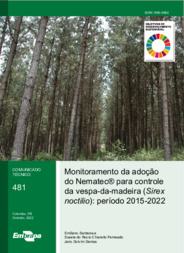Manejo Integrado de Pragas: vespa-da-madeira
Integrated pest management - wood wasps

Photo: PICHELLI, Katia
In 1988, Embrapa Florestas detected and registered the arrival of the wood wasp Sirex noctilio in Brazil. Currently, this pest is estimated to be present in approximately 1 million hectares of pine stands in Paraná, Santa Catarina, Rio Grande do Sul, São Paulo, and Minas Gerais. Because it is an exotic species, introduced without its network of natural enemies, the wood wasp has become the main pest in pine plantations, posing a threat to roughly 1.6 million ha planted with this species in the country. A joint effort by institutions linked to the sector established the Brazilian National Program for Wood Wasp Control (PNCVM) and the National Fund for Forest Pest Control (Funcema). PNCVM established strategies for integrated pest management using environmentally appropriate technologies, since it recommends silvicultural techniques for prevention and biological control that do not cause any environmental contamination. It is a safe technology that specifically targets wood wasps and does not affect beneficial insects, reducing losses in biomass production and sequestering greater quantities of carbon dioxide.
This technological solution was developed by Embrapa in partnership with other institution(s).
Where to find:
- Vídeo: https://youtu.be/IbiMte-b2zM
- Publicação: Manual para o controle da vespa-da-madeira em plantios de pinus - https://www.embrapa.br/busca-de-publicacoes/-/publicacao/1034558/manual-para-o-controle-da-vespa-da-madeira-em-plantios-de-pinus
Agricultural practice: For plant pest management Launch year: 1989
Country: Brazil Region: Southeast State: Espírito Santo, Minas Gerais, Rio de Janeiro, São Paulo, Paraná, Rio Grande do Sul, Santa Catarina Biome: Atlantic Rainforest, Pampa
Responsible Unit: Embrapa Forestry





